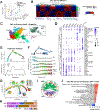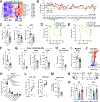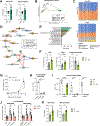Microbiota triggers STING-type I IFN-dependent monocyte reprogramming of the tumor microenvironment
- PMID: 34624222
- PMCID: PMC8650838
- DOI: 10.1016/j.cell.2021.09.019
Microbiota triggers STING-type I IFN-dependent monocyte reprogramming of the tumor microenvironment
Abstract
The tumor microenvironment (TME) influences cancer progression and therapy response. Therefore, understanding what regulates the TME immune compartment is vital. Here we show that microbiota signals program mononuclear phagocytes in the TME toward immunostimulatory monocytes and dendritic cells (DCs). Single-cell RNA sequencing revealed that absence of microbiota skews the TME toward pro-tumorigenic macrophages. Mechanistically, we show that microbiota-derived stimulator of interferon genes (STING) agonists induce type I interferon (IFN-I) production by intratumoral monocytes to regulate macrophage polarization and natural killer (NK) cell-DC crosstalk. Microbiota modulation with a high-fiber diet triggered the intratumoral IFN-I-NK cell-DC axis and improved the efficacy of immune checkpoint blockade (ICB). We validated our findings in individuals with melanoma treated with ICB and showed that the predicted intratumoral IFN-I and immune compositional differences between responder and non-responder individuals can be transferred by fecal microbiota transplantation. Our study uncovers a mechanistic link between the microbiota and the innate TME that can be harnessed to improve cancer therapies.
Keywords: STING; cancer immunology; dendritic cells; immune checkpoint blockade immunotherapy; innate immunity; interferon; macrophages; microbiota; monocytes; tumor microenvironment.
Published by Elsevier Inc.
Conflict of interest statement
Declaration of interests J.A.W. is an inventor on a US patent application (PCT/US17/53.717) relevant to the current work; reports compensation for speaker’s bureau and honoraria from Imedex, Dava Oncology, Omniprex, Illumina, Gilead, PeerView, MedImmune, and Bristol-Myers Squibb (BMS); and serves as a consultant/advisory board member for Roche/Genentech, Novartis, AstraZeneca, GlaxoSmithKline, BMS, Merck, Biothera Pharmaceuticals, and Micronoma. All other authors have no competing interests.
Figures







Comment in
-
Microbiota regulates intratumoral monocytes to promote anti-tumor immune responses.Cell. 2021 Oct 14;184(21):5301-5303. doi: 10.1016/j.cell.2021.09.024. Epub 2021 Oct 7. Cell. 2021. PMID: 34624223
References
-
- Bae HR, Leung PSC, Hodge DL, Fenimore JM, Jeon SM, Thovarai V, Dzutsev A, Welcher AA, Boedigheimer M, Damore MA, et al. (2020). Multi-omics: Differential expression of IFN-gamma results in distinctive mechanistic features linking chronic inflammation, gut dysbiosis, and autoimmune diseases. J Autoimmun 111, 102436. - PMC - PubMed
Publication types
MeSH terms
Substances
Supplementary concepts
Grants and funding
LinkOut - more resources
Full Text Sources
Other Literature Sources
Molecular Biology Databases
Research Materials

